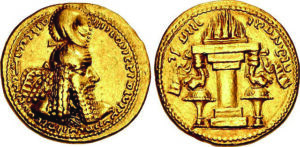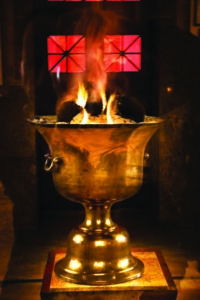 Today, 20th April, 2024, is Roj Adar of Mah Adar. In other words, it is the Parab of Adar – the Divinity that presides over fire. Little wonder that Roj Adar of Mah Adar is the day when several Agyari and Atash Behram were consecrated and enthroned, including the Holiest of Holy, Iranshah! Consecration is an act or manner of making the ordinary sacred or worthy of reverence, through ritual purification.
Today, 20th April, 2024, is Roj Adar of Mah Adar. In other words, it is the Parab of Adar – the Divinity that presides over fire. Little wonder that Roj Adar of Mah Adar is the day when several Agyari and Atash Behram were consecrated and enthroned, including the Holiest of Holy, Iranshah! Consecration is an act or manner of making the ordinary sacred or worthy of reverence, through ritual purification.
Zoroastrians refer to fire as Atash (Avesta Atar) (Persian Azar) and consider fire as the visible presence of Ahura Mazda and His Asha (Truth and Divine Order). Zoroastrians pay homage to the Creator through fire as the channel or medium. There are three grades of Fire. The highest is Atash Behram or the fire that gives Victory. We have four Atash Behram in Mumbai, two in Surat, one in Navsari, and one in Udwada. The oldest is the one in Udwada which has been continuously burning for more than a thousand years. It is called Iranshah as it is the first Holy fire that we consecrated in India after coming from Iran, using the Aalaat (sacred ritual requisites, including the Holy Ash), brought from Khorasan.
Life And Fire
It is an interesting scientific fact that Earth is the only planet with fire. Fire requires a specific chemical reaction that needs fuel and oxygen; it cannot exist without life. Earth is known as a watery planet. What’s interesting is that it is possibly the only fiery planet in the known universe. The sun is mostly hydrogen undergoing nuclear fusion and not fire, as we may tend to imagine. Magma from volcanoes, and lightning observed on other planets, is also not fire. To ignite fire, it took billions of years of photosynthesis. This means fire began with life and fire cannot exist without life. Amazingly, fire and life have been shaping each other ever since plant life began on planet earth. It is this interplay between fire and life that Zoroastrians respect daily and celebrate more specially on the Parab of Adar!
 Roots Of Reverence
Roots Of Reverence
According to Ferdowsi’s Shahnameh, fire was accidentally discovered during the pre-historic Peshdad period by Shah Hooshang, when Hooshang threw a rock at a serpent-like creature and missed the target, striking another rock instead. Sparks from that friction ignited some dry grass in the surrounding area. Hooshang recognized this fire as the Divine Glory of Ahura Mazda and instructed his subjects to offer homage.
Zoroastrians have given importance to fire since ancient times. Even more than two and half millennia ago, the Astodan or the final resting place of most of the Great Achaemenian Kings, including that of Darius, Xerxes and Artaxerxes, depict the great Kings offering homage before a fire altar. Coins of the later Sasanian period, beginning with the founder, Ardashir, also carried the symbol of fire.
Homage To The Hearth Fire
The feast of Adar actually begins the day before (Roj Dae-pa-Adar) when household women celebrate the Chulah-nu-varas, which literally means birthday of the hearth Fire. The kitchen is cleaned and the area around the hearth fire is decorated and garlanded with marigold flowers. The devout do not use the stove in the kitchen from early evening (Uzirin Gah) till the next morning.
According to the Bundahishn, which is a Zoroastrian text, equivalent to the Book of Genesis in the Old Testament, Adar is associated with the marigold (calendula) flower. Marigold is believed to have derived its name from ‘Mary’s Gold’, taken from the fact that early Christians placed flowers instead of coins on Mother Mary’s altar as an offering. This flower is often used in festivities honoring Mary. Hindus use it during marriages and Zoroastrians associate this flower with fire, because of its colour.
Ninth Day And Ninth Month
In the Zoroastrian calendar, Adar is the ninth day of every month of thirty days and also the ninth month of the year of twelve months. Nine is a sacred number across several religious traditions. In the Zoroastrian tradition, Prophet Zarathustra is often depicted holding a nine-knotted stick called Navgar. Among Hindus, nine is the number of Brahma, the Creator. Among Christians, number nine symbolizes divine completeness and conveys the meaning of finality. Christ died on the cross at the ninth hour of the day (03:00 pm) to pave the path of salvation for everyone. Also, Jesus appears nine times to his disciples and apostles after his resurrection. Mathematically, when multiplied nine always reproduces itself.
Interestingly, Adar (Akkadian Adaru) is also the twelfth month of the ecclesiastical year on the Hebrew calendar. The Hebrew name Adar (pronounced ‘Ay daar’) is related to the word Adir which denotes strength and power.
Why Zoroastrian Pray In The Presence Of Fire
In Zoroastrian cosmogony, Ahura Mazda created this world in six stages (the six Gahambars) creating first the sky, water, earth, vegetation, animal and finally man. However, what animated or gave energy to all these six good creations was Adar or fire. Both, the Bundahishn and Zatspram, explain that Ahura Mazda’s six good creations were able to commence their work, thanks to Adar as the life-giving force or energy. Thus, from a Zoroastrian perspective, fire is both a giver of light and giver of life. Neither darkness nor evil has an existence of its own. Just as darkness is merely the absence of light, so is evil the absence of good. Thus, while fire dispels darkness, evil is dispelled each time we choose to think, speak and perform a good deed.
The concept of having a hearth fire or in modern times, at least a diva at home, is a ritual form of dispelling darkness and evil with the presence of light. The Persian Revayet recommend that we should pray five Yatha while lighting a diva. Yatha is the chant (The Ahunavar and equivalent of the Sanskrit Om) with which Ahura Mazda created this universe. Also, while reciting the Sarosh Baj (Sarosh Yazata is the guardian of the souls of the living as also the dead) we pray five Yatha. Hence, praying five Yatha while lighting a Fire, probably has a link with enlightening or enhancing our five senses, or our consciousness and an act of attuning our spirit with the Creator, the chant with which the universe was created and the energy of fire that animated or energized all creation.
Adar (Avestan ātar) is Hamkar (co-helper) of Ardibehesht (Avestan Asha Vahishta literally meaning Best Truth or Righteousness). Indeed, when a Zoroastrian prays before fire, he/she looks up to Ahura Mazda the Creator through fire as a form of Light and Life. Also, since Ardibehesht, along with Adar is the Divinity protecting fire and Ardibehesht is the embodiment of Truth and Righteousness (Asha Vahishta), praying before fire is an affirmation of upholding Truth and Righteousness in our lives.
- In Search Of The Soul - 5 April2025
- Why Pray In A Language We Do Not Understand? - 29 March2025
- Celebrate Nature’s New Year With Purity And Piety of Ava - 22 March2025
